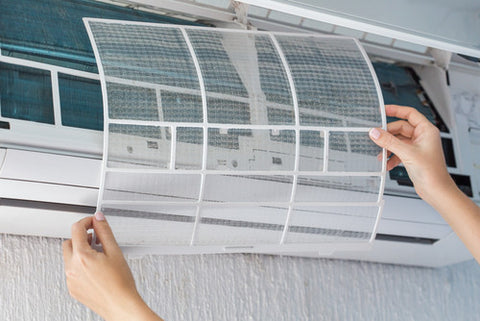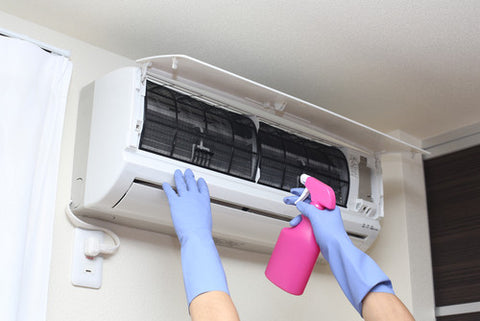We already discussed what to do when your air conditioner goes on the fritz. In most cases, you’re going to need to call an HVAC qualified service tech to come out and take a look. Now, there are some things that you can’t prevent when it comes to your air conditioner breaking down. Low refrigerant, mechanical failures, and accidents happen. But there are plenty of things that you can do to help make sure that your air conditioner stays in the best shape it can be.
When it comes to a schedule of preventive maintenance, there are two primary things that you as a homeowner can keep on top of. Those are filters, and cleaning of the registers, outdoor parts, and indoor components. If you have a window unit, you don’t have to worry about the registers.
Before you start any maintenance on your air conditioner, make sure that you’ve turned off the power to the unit at the breaker box.
Changing Your Filters
 This is probably the most important preventive maintenance job you can do for your air conditioner. If you have central air that runs through your ductwork, you’re going to have box filters that filter all of the air going through your HVAC system. If you have a split system or window units, your filter will likely be a washable filter located in the inside portion of your AC.
This is probably the most important preventive maintenance job you can do for your air conditioner. If you have central air that runs through your ductwork, you’re going to have box filters that filter all of the air going through your HVAC system. If you have a split system or window units, your filter will likely be a washable filter located in the inside portion of your AC.
For box filters, the rule of thumb is that your filter will last one month for every inch of thickness. That means a 1-inch filter will filter effectively for about one month. Of course, depending on how often you run your HVAC and the environment, your filter may last longer or require changing more often. Also, when you get a filter for your HVAC system, you want to aim for a MERV rating of 8 to 11. If you have allergies, get a higher rating as it will filter more allergens out of your air.
In general, 3-inch filters will provide the most value for your dollar, letting you buy a four or five pack of filters and store them in your basement or garage for the year. Those will need to be changed every quarter, and as you use the last one, you can simply reorder more.
If you have a permanent and washable box filter, make sure to use low-pressure water and to rinse from the back of the filter. You want the dirt and residue to come out the same way it came in. Rinsing the filter from the front forces the particles through the filtering medium and creates pathways that reduce the effectiveness of the filter in the future.
For window and split units, remove the washable and reusable filter and rinse it from the back. Again, even if your filter is very coarse and you can see through it, you don’t want to rinse it from the front. Don’t use any sort of harsh chemicals such as bleach or ammonia. If your filter is exceptionally dirty, use a soft brush and a few drops of dishwashing liquid to clean it. Let it dry completely before you reinstall it and turn your unit back on.
Cleaning Up
 By far the most important area for you to clean on your air conditioner is the condenser area. Without adequate airflow through here, you’re risking having the tubing start to collect ice and then freeze solid. Cleaning it may seem complicated, but it really isn’t. When you go to clean the outside portion of your HVAC or split AC, make sure that it’s at least 60 degrees Fahrenheit.
By far the most important area for you to clean on your air conditioner is the condenser area. Without adequate airflow through here, you’re risking having the tubing start to collect ice and then freeze solid. Cleaning it may seem complicated, but it really isn’t. When you go to clean the outside portion of your HVAC or split AC, make sure that it’s at least 60 degrees Fahrenheit.
You want to clean the condenser fins, which look like thin metallic sheets that surround the intake portion of your AC. As these get dirty and clog with grass, leaves, and other material, your air flow to the AC is restricted, putting it at risk of icing up.
Use a soft dusting brush attachment to clean the fins. You don’t want to press too hard because the fins are extremely soft and prone to bending. If you do find any that are bent, use a fin comb to straighten them. This is a special tool you can find at most hardware stores and it ensures that your condenser fins have appropriate spacing. If you notice a large number of fins have been bent or crushed, you can have a service technician take care of them.
Next, remove the housing from the outdoor unit. Use the same soft brush to vacuum the interior. You likely won’t be able to remove it entirely because of the wires attaching it to the control box, but you should get enough room to clean inside.
For whole-house HVAC systems, use this time to clean your ducts and registers as well. You don’t have to remove them to clean inside but vacuum and inspect them to ensure that there is adequate air flow.
For window units, clean the fins and remove the back portion. You should be able to remove the entire metal housing, letting you vacuum inside completely.
When you restart your air conditioner, turn the switch from cool to off. Let the unit run for a full 24 hours before you start cooling again to ensure that the internal lubricant has had a chance to warm.
A schedule of preventive maintenance will ensure that your summers are kept at the temperature you want them to be. It takes about an hour every month to ensure that your air conditioner is in the best shape it can be and will help you avoid costly and unnecessary service calls.


